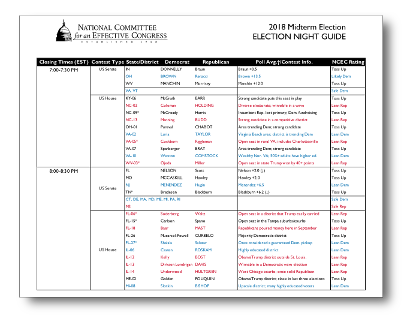 After a long wait, voters have a chance to deliver their verdict on the first two years of Donald Trump’s presidency. With the election tomorrow, history suggests that the Democrats are poised to make big gains in Congress, including the potential for control of the House of Representatives. But unlike previous wave elections which extended to both chambers of Congress, we see a more muddled picture where Democrats do well in the House, while the Republicans maintain or slightly grow their majority in the Senate.
After a long wait, voters have a chance to deliver their verdict on the first two years of Donald Trump’s presidency. With the election tomorrow, history suggests that the Democrats are poised to make big gains in Congress, including the potential for control of the House of Representatives. But unlike previous wave elections which extended to both chambers of Congress, we see a more muddled picture where Democrats do well in the House, while the Republicans maintain or slightly grow their majority in the Senate.
Reasons for Optimism
History suggests that Election Night will be a good one for the Democrats, and delving into the specific contests gives reason for optimism:
- Nearly 60 Vulnerable House Republicans: Our final battleground analysis finds a wealth of targets for the Democrats across every demographic group and geographic region. Recent polling highlights almost 20 Republican seats the Democrats are already expected to win, and places many more in the “toss up” category. It is highly unlikely that the Republicans will win enough of these districts to hold Democratic gains below the 23 seats needed to take the chamber.
- Traditional Metrics are Holding Up: Democrats have maintained a healthy advantage on the generic congressional ballot; President Trump’s job approval rating, though slightly up, is still in the mid 40s; and Americans appear pessimistic about the direction of the country. Taken together, these point to a good night for the Democrats
- Voter Enthusiasm: Throughout the cycle Democratic participation in primaries and special elections has been elevated, and we expect that enthusiasm to hold through Election Day. College educated women and suburban voters are at the heart of the Democratic strategy, and both cohorts appear poised to turnout in large numbers.
- Unexpected Opportunity in the Senate: The Senate map this cycle always favored the Republicans, but strong political headwinds and well run campaigns have given many of the vulnerable Democratic incumbents a solid chance to hold their seats. Plus, the emergence of Tennessee and Texas as legitimate battlegrounds has given the Democrats hope of even modest gains, keeping the Senate in play in 2020.
Reasons for Caution
Though the overall electoral battleground favors the Democrats, there are still reasons to temper expectations:
- Republican Enthusiasm Has Increased: As expected, Republican interest and natural partisan preference has increased as the election approaches, which has caused the polls to fluctuate and brought some expectations back to earth.
- Republican Gerrymandering: Even in a favorable political environment, Democratic candidates in battleground states will be forced to overcome district lines that favor the Republican incumbents. Overall, it is estimated that Democrats need a national advantage of 6 to 7 points to take back the House.
- The Senate Map Still Favors Republicans: While Democratic prospects improved throughout the cycle, Republicans still have a natural advantage. The seats in Florida, Indiana, Missouri, Montana, New Jersey and North Dakota remain very much in play. On the Democratic side, Arizona, Nevada, Tennessee, and Texas remain potential pickups, but polling suggests that momentum is fading.
To help you navigate the election, we have prepared our Election Night Scorecard that highlights the key races that will determine who controls the House and Senate. Thank you to all the members who have made our work possible this cycle.
